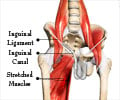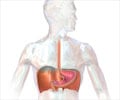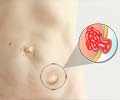Types of Hernia
The abdominal wall isn't a solid sheet of muscle; it is made up of different layers. When a weakness or tear occurs in this muscle, part of the intestine bulges through and appears as a lump under the skin. The most common hernia occurs in the groin and is called inguinal hernia.
Inguinal - This is the most common form of Hernia and occurs in the groin, accounting for more than nine out of 10 hernias. Inguinal hernias affect more men than women, and are particularly common in middle age. A loop of intestine pushes against the small ring of muscle in the groin, eventually splitting the muscle fibers apart. These hernias are divided into 2 different types, direct and indirect.
An indirect inguinal hernia follows the pathway that the testicles made during prebirth development. It descends from the abdomen into the scrotum through the inguinal canal. The direct inguinal hernia occurs slightly to the inside of the site of the indirect hernia, in a place where the abdominal wall is naturally slightly thinner. It rarely will descend down towards the scrotum.
Femoral – This hernia causes a bulge below the inguinal crease, on the inner aspect of the thigh. Similar to the events that cause an inguinal hernia, intestines force their way through the weak muscle ring at the femoral canal until they protrude. This herniated section of bowel is at risk of strangulation, which is a serious complication requiring urgent medical attention. Femoral hernias are more common in women due to their wider and roomier pelvis.
Umbilical - a portion of the gut pushes through a muscular weakness near the navel, or belly button. This type of hernia is more common in newborns. Overweight women, or those who have had several pregnancies, are also at increased risk.
Incisional - after abdominal surgery, the site of repair will always be structurally weaker. Sometimes, the intestines can push through the closed incision, causing a hernia. This occurs after 2-10% of all abdominal surgeries, although people with Diabetes are more at risk. After surgical repair, incisional hernias have a high rate of returning (20-45%).
Spigelian hernia: This rare hernia occurs along the edge of a midline muscle called the rectus abdominus. The bulge is seen several inches to the side of the middle of the abdomen.
Obturator hernia: This extremely rare abdominal hernia happens mostly in women. This hernia protrudes from the pelvic cavity through an opening in the pelvic bone (Obturator foramen). This will not show any bulge but can cause bowel obstruction
Epigastric hernia: Occurring between the navel and the lower part of the rib cage in the midline of the abdomen, epigastric hernias are composed usually of fatty tissue and rarely contain intestine. Formed in an area of relative weakness of the abdominal wall, these hernias are often painless.


















